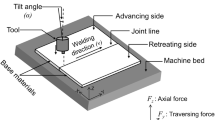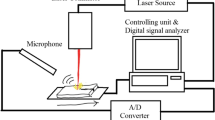Abstract
For control of real-time Internet of Things (IoT)-based remote welding process, continuous detection of defects occurring in the weld sample is of utmost importance so that welding parameters can be changed accordingly to avoid further occurrence of such defects. Time-frequency domain signal processing method, such as discrete wavelet transform (DWT), can be applied for detection of such defects. DWT continuously decomposes a signal into detailed and approximate coefficients through its associated filter banks and provides a time-frequency domain representation of a signal. Different levels of decomposition capture different frequency components, and hence, there is a need for optimization of the level of decomposition of force and power signals recorded during joining of two aluminum sheets by friction stir welding (FSW), for correct identification and localization of defects occurring in the process. Internal defects in the weld samples are further verified by CT scan images. Statistical tools have been used to study the variations in the DWT coefficients due to both internal and surface defects. An attempt has been made to compare between force and power signals as to which gives better defect detection.
Similar content being viewed by others
References
Walden S, Michael G, Temple-smith P (1995) 5:460–317
Citarella R, Carlone P, Lepore M, Palazzo GS (2015) Numerical-experimental crack growth analysis in AA2024-T3 FSWed butt joints. Adv Eng Softw 80:47–57. https://doi.org/10.1016/j.advengsoft.2014.09.018
Wang H, Colegrove PA, Mehnen J (2014) Hybrid modelling of the contact gap conductance heat transfer in welding process. Adv Eng Softw 68:19–24. https://doi.org/10.1016/j.advengsoft.2013.11.001
Benyounis KY, Olabi AG (2008) Optimization of different welding processes using statistical and numerical approaches - a reference guide. Adv Eng Softw 39:483–496. https://doi.org/10.1016/j.advengsoft.2007.03.012
Mandal S, Rice J, Elmustafa AA (2008) Experimental and numerical investigation of the plunge stage in friction stir welding. J Mater Process Technol 203:411–419. https://doi.org/10.1016/j.jmatprotec.2007.10.067
Kumar K, Kalyan C, Kailas SV, Srivatsan TS (2009) An investigation of friction during friction stir welding of metallic materials. Mater Manuf Process 24:438–445. https://doi.org/10.1080/10426910802714340
Cui S, Chen ZW, Robson JD (2010) A model relating tool torque and its associated power and specific energy to rotation and forward speeds during friction stir welding/processing. Int J Mach Tools Manuf 50:1023–1030. https://doi.org/10.1016/j.ijmachtools.2010.09.005
Kumar R, Singh K, Pandey S (2012) Process forces and heat input as function of process parameters in AA5083 friction stir welds. Trans Nonferrous Metals Soc China 22:288–298. https://doi.org/10.1016/S1003-6326(11)61173-4
Trimble D, Monaghan J, O’Donnell GE (2012) Force generation during friction stir welding of AA2024-T3. CIRP Ann Manuf Technol 61:9–12. https://doi.org/10.1016/j.cirp.2012.03.024
Pew JW, Nelson TW, Sorensen CD (2007) Torque based weld power model for friction stir welding. Sci Technol Weld Join 12:341–347. https://doi.org/10.1179/174329307X197601
Mehta M, Chatterjee K, De A (2013) Monitoring torque and traverse force in friction stir welding from input electrical signatures of driving motors. Sci Technol Weld Join 18:191–197. https://doi.org/10.1179/1362171812Y.0000000084
Su H, Wu CS, Pittner A, Rethmeier M (2013) Simultaneous measurement of tool torque, traverse force and axial force in friction stir welding. J Manuf Process 15:495–500. https://doi.org/10.1016/j.jmapro.2013.09.001
Razal Rose A, Manisekar K, Balasubramanian V (2011) Effect of axial force on microstructure and tensile properties of friction stir welded AZ61A magnesium alloy. Trans Nonferrous Metals Soc China 21:974–984. https://doi.org/10.1016/S1003-6326(11)60809-1
Chen C, Kovacevic R, Jandgric D (2003) Wavelet transform analysis of acoustic emission in monitoring friction stir welding of 6061 aluminum. Int J Mach Tools Manuf 43:1383–1390. https://doi.org/10.1016/S0890-6955(03)00130-5
Ramulu PJ, Narayanan RG, Kailas SV, Reddy J (2013) Internal defect and process parameter analysis during friction stir welding of Al 6061 sheets. Int J Adv Manuf Technol 65:1515–1528. https://doi.org/10.1007/s00170-012-4276-z
Fratini L, Buffa G (2005) CDRX modelling in friction stir welding of aluminium alloys. Int J Mach Tools Manuf 45:1188–1194. https://doi.org/10.1016/j.ijmachtools.2004.12.001
Jiménez-Macías E, Sánchez-Roca A, Carvajal-Fals H, Blanco-Fernández J, Martínez-Cámara E (2014) Wavelets application in prediction of friction stir welding parameters of alloy joints from vibroacoustic ANN-based model. Abstr Appl Anal 2014:1–11. https://doi.org/10.1155/2014/728564
Chen HB, Yan K, Lin T et al (2006) The investigation of typical welding defects for 5456 aluminum alloy friction stir welds. Mater Sci Eng A 433:64–69. https://doi.org/10.1016/j.msea.2006.06.056
Soundararajan V, Atharifar H, Kovacevic R (2006) Monitoring and processing the acoustic emission signals from the friction-stir-welding process. Proc Inst Mech Eng B J Eng Manuf 220:1673–1685. https://doi.org/10.1243/09544054JEM586
Bhat NN, Kumari K, Dutta S, Pal SK, Pal S (2015) Friction stir weld classification by applying wavelet analysis and support vector machine on weld surface images. J Manuf Process 20:274–281. https://doi.org/10.1016/j.jmapro.2015.07.002
Das B, Pal S, Bag S (2014) Monitoring of friction stir welding process through signals acquired during the welding. 1–7
Jose A, Babu AS, Kumar VSS (2013) Analysis of acoustic signals in friction stir welding. 161–164
Kumar U, Yadav I, Kumari S, Kumari K, Ranjan N, Kesharwani RK, Jain R, Kumar S, Pal S, Chakravarty D, Pal SK (2015) Defect identification in friction stir welding using discrete wavelet analysis. Adv Eng Softw 85:43–50. https://doi.org/10.1016/j.advengsoft.2015.02.001
Das B, Pal S, Bag S (2017) Weld quality prediction in friction stir welding using wavelet analysis. Int J Adv Manuf Technol 89:711–725. https://doi.org/10.1007/s00170-016-9140-0
Sinha P, Muthukumaran S, Sivakumar R, Mukherjee SK (2008) Condition monitoring of first mode of metal transfer in friction stir welding by image processing techniques. Int J Adv Manuf Technol 36:484–489. https://doi.org/10.1007/s00170-006-0854-2
Tansel IN, Demetgul M, Okuyucu H, Yapici A (2010) Optimizations of friction stir welding of aluminum alloy by using genetically optimized neural network. Int J Adv Manuf Technol 48:95–101. https://doi.org/10.1007/s00170-009-2266-6
Huggett DJ, Liao TW, Wahab MA, Okeil A (2017) Prediction of friction stir weld quality without and with signal features. Int J Adv Manuf Technol 95:1–15. https://doi.org/10.1007/s00170-017-1403-x
Babajanzade Roshan S, Behboodi Jooibari M, Teimouri R, Asgharzadeh-Ahmadi G, Falahati-Naghibi M, Sohrabpoor H (2013) Optimization of friction stir welding process of AA7075 aluminum alloy to achieve desirable mechanical properties using ANFIS models and simulated annealing algorithm. Int J Adv Manuf Technol 69:1803–1818. https://doi.org/10.1007/s00170-013-5131-6
Kamal Babu K, Panneerselvam K, Sathiya P, Noorul Haq A, Sundarrajan S, Mastanaiah P, Srinivasa Murthy CV (2017) Parameter optimization of friction stir welding of cryorolled AA2219 alloy using artificial neural network modeling with genetic algorithm. Int J Adv Manuf Technol 94:3117–3129. https://doi.org/10.1007/s00170-017-0897-6
Li JQ, Liu HJ (2014) Optimization of welding parameters for the reverse dual-rotation friction stir welding of a high-strength aluminum alloy 2219-T6. Int J Adv Manuf Technol 76:1469–1478. https://doi.org/10.1007/s00170-014-6352-z
Zhao S, Bi Q, Wang Y, Shi J (2017) Empirical modeling for the effects of welding factors on tensile properties of bobbin tool friction stir-welded 2219-T87 aluminum alloy. Int J Adv Manuf Technol 90:1105–1118. https://doi.org/10.1007/s00170-016-9450-2
Das B, Bag S, Pal S (2016) Defect detection in friction stir welding process through characterization of signals by fractal dimension. Manuf Lett 7:6–10. https://doi.org/10.1016/j.mfglet.2015.11.006
Adelson EH, Anderson CH, Bergen JR, Burt PJ, Ogden JM (1984) Pyramid methods in image processing. RCA Eng:33–41
Ranjan R, Reza A, Parikh C et al (2016) Classification and identification of surface defects in friction stir welding: an image processing approach. J Manuf Process 22:237–253. https://doi.org/10.1016/j.jmapro.2016.03.009
Kumari S, Jain R, Kumar U, Yadav I, Ranjan N, Kumari K, Kesharwani RK, Kumar S, Pal S, Pal SK, Chakravarty D (2016) Defect identification in friction stir welding using continuous wavelet transform. J Intell Manuf 1–12. https://doi.org/10.1007/s10845-016-1259-1
Das B, Pal S, Bag S (2016) A combined wavelet packet and Hilbert-Huang transform for defect detection and modelling of weld strength in friction stir welding process. J Manuf Process 22:260–268. https://doi.org/10.1016/j.jmapro.2016.04.002
Parikh C, Ranjan R, Khan AR, Jain R, Mahto RP, Chakravarty D, Pal S, Pal SK (2017) Volumetric defect analysis in friction stir welding based on three dimensional reconstructed images. J Manuf Process 29:96–112. https://doi.org/10.1016/j.jmapro.2017.07.006
Sahu PK, Kumari K, Pal S, Pal SK (2016) Hybrid fuzzy-grey-Taguchi based multi weld quality optimization of Al/cu dissimilar friction stir welded joints. Adv Manuf 4:237–247. https://doi.org/10.1007/s40436-016-0151-8
Liu F, Liu S, Guo E, Li L (2008) Ultrasonic evaluation of friction stir welding. 17th World Conf Nondestruct. 25–28
Author information
Authors and Affiliations
Corresponding author
Rights and permissions
About this article
Cite this article
Roy, R.B., Ghosh, A., Bhattacharyya, S. et al. Weld defect identification in friction stir welding through optimized wavelet transformation of signals and validation through X-ray micro-CT scan. Int J Adv Manuf Technol 99, 623–633 (2018). https://doi.org/10.1007/s00170-018-2519-3
Received:
Accepted:
Published:
Issue Date:
DOI: https://doi.org/10.1007/s00170-018-2519-3




